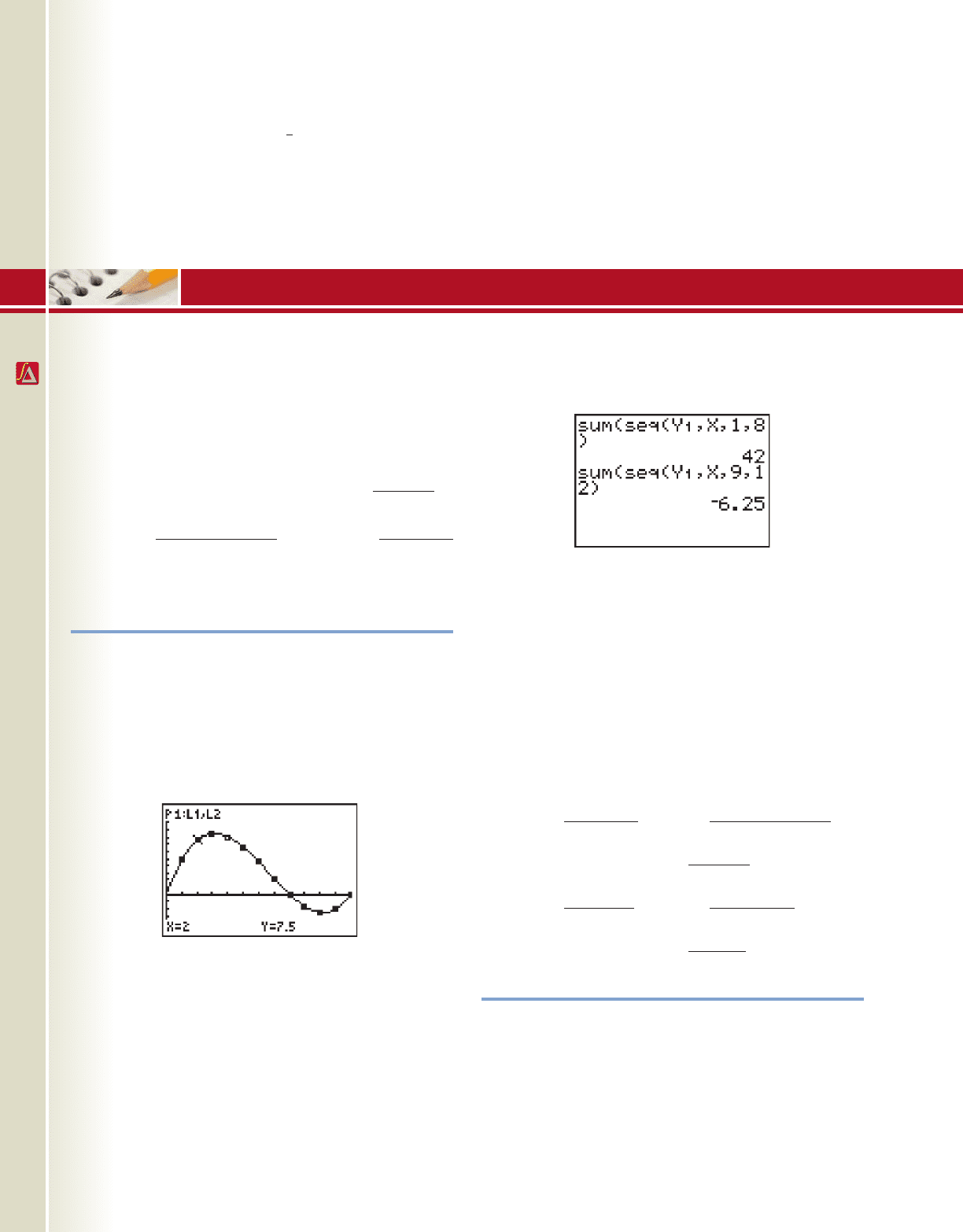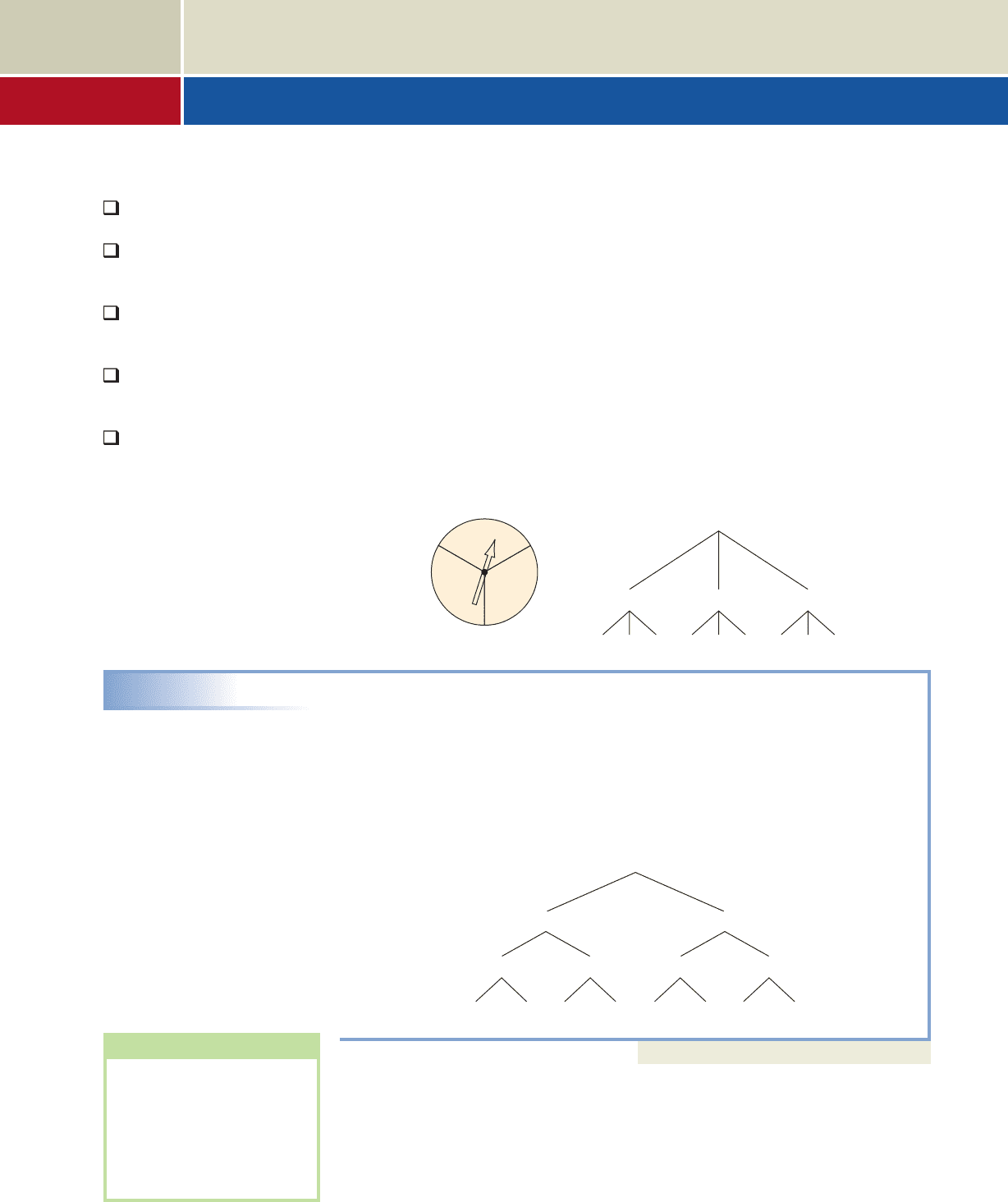Coburn J.W. Algebra and Trigonometry
Подождите немного. Документ загружается.


1050 CHAPTER 11 Additional Topics in Algebra 11-34
WORKING WITH FORMULAS
25. Sum of the first n cubes (alternative form):
(1 + 2 + 3 + 4 + + n)
2
Earlier we noted the formula for the sum of the
first n cubes was An alternative is given
by the formula shown.
a. Verify the formula for , and 9.
b. Verify the formula using
.1 2 3
p
n
n1n 12
2
n 1, 5
n
2
1n 12
2
4
.
p
26. Powers of the imaginary unit: i
n 4
i
n
, where
i =
Use a proof by induction to prove that powers of
the imaginary unit are cyclic. That is, that they
cycle through the numbers i, and 1 for
consecutive powers.
1, i,
11
APPLICATIONS
Use mathematical induction to prove the indicated sum
formula is true for all natural numbers n.
27.
28.
29.
30.
31.
32.
33.
34.
35.
a
n
2
n
, S
n
2
n1
2
2 4 8 16 32 64
p
2
n
;
a
n
5
n
, S
n
515
n
12
4
5 25 125 625
p
5
n
;
a
n
3
n
, S
n
313
n
12
2
3 9 27 81 243
p
3
n
;
a
n
8n 4, S
n
4n
2
4 12 20 28 36
p
18n 42;
a
n
4n 1, S
n
n12n 32
5 9 13 17
p
14n 12;
a
n
3n 2, S
n
n13n 12
2
1 4 7 10 13
p
13n 22;
a
n
5n, S
n
5n1n 12
2
5 10 15 20 25
p
5n;
a
n
4n 1, S
n
n12n 12
3 7 11 15 19
p
14n 12;
a
n
2n, S
n
n1n 12
2 4 6 8 10
p
2n;
36.
37.
38.
Use the principle of mathematical induction to prove
that each statement is true for all natural numbers n.
39. 40.
41. 42.
43. is divisible by 2
44. is divisible by 3
45. is divisible by 3
46. is divisible by 4
47. is divisible by 56
n
1
5
n
1
n
3
3n
2
2n
n
3
n 3
n
2
7n
4
#
5
n1
5
n
13
#
4
n1
4
n
1
2
n
n 13
n
2n 1
a
n
1
n1n 12
, S
n
n
n 1
1
1122
1
2132
1
3142
p
1
n1n 12
;
a
n
1
12n 1212n 12
, S
n
n
2n 1
1
1132
1
3152
1
5172
p
1
12n 1212n 12
;
a
n
n
3
, S
n
n
2
1n 12
2
4
1 8 27 64 125 216
p
n
3
;
EXTENDING THE THOUGHT
48. You may have noticed that the sum formula for the
first n integers was quadratic, and the formula for the
first n integer squares was cubic. Is the formula for
the first n integer cubes, if it exists, a quartic (degree
four) function? Use your calculator to run a quartic
regression on the first five perfect cubes (enter 1
through 5 in L
1
and the cumulative sums in L
2
). What
did you find? Use proof by induction to show that the
sum of the first n cubes is:
n
2
1n 12
2
4
.
n
4
2n
3
n
2
4
1 8 27
p
n
3
College Algebra & Trignometry—
cob19529_ch11_1044-1052.qxd 12/10/08 7:54 PM Page 1050 epg HD 049:Desktop Folder:Coburn_do_t del-ch11:

49. Use mathematical induction to prove that
x
n
1
x 1
11 x x
2
x
3
p
x
n1
2.
50. Use mathematical induction to prove that for
where
S
n
n1n 1212n 1213n
2
3n 12
30
.
a
n
n
4
,1
4
2
4
3
4
p
n
4
,
11-35 Mid-Chapter Check 1051
MAINTAINING YOUR SKILLS
51. (6.2) Verify the identity
52. (2.7) State the domain and range of the piecewise
function shown here.
532154321
1
2
3
4
5
2
3
4
1
5
x
y
(3, 2)
(1, 1)
1sin cos 2
2
1sin cos 2
2
2.
53. (2.1) State the equation of the circle whose graph
is shown here.
54. (7.4) Given and , find
a. the dot product
b. the angle between the vectors
p
#
q
q H1, 1Ip H13
, 1I
(1, 7)
(4, 3)
108642108642
2
4
6
8
10
4
6
8
2
10
x
y
In Exercises 1 to 3, the nth term is given. Write the first
three terms of each sequence and find a
9
.
1. 2.
3.
4. Evaluate the sum
5. Rewrite using sigma notation.
Match each formula to its correct description.
6.
7.
8.
9.
10
.
a. sum of an infinite geometric series
b. nth term formula for an arithmetic series
S
n
a
1
11 r
n
2
1 r
a
n
a
1
1n 12d
S
q
a
1
1 r
a
n
a
1
r
n1
S
n
n1a
1
a
n
2
2
1 4 7 10 13 16
4
n1
3
n1
a
n
112
n
12n 12
a
n
n
2
3a
n
7n 4
c. sum of a finite geometric series
d. summation formula for an arithmetic series
e. nth term formula for a geometric series
11. Identify a
1
and the common difference d. Then find
an expression for the general term a
n
.
a. 2, 5, 8, 11, . . . b. 3, . . .
Find the number of terms in each series and then find
the sum.
12.
13.
14. For an arithmetic series, and
Find S
10
.
15. For a geometric series, and
Find S
10
.
16. Identify a
1
and the common ratio r. Then find an
expression for the general term a
n
.
a. 2, 6, 18, 54, . . . b.
17. Find the number of terms in the series then compute
the sum.
1
54
1
18
1
6
p
81
2
1
2
,
1
4
,
1
8
,
1
16
, . . .
a
7
1.a
3
81
a
7
4.a
3
8
1
2
3
2
5
2
7
2
p
31
2
2 5 8 11
p
74
15
4
,
3
2
,
9
4
,
MID-CHAPTER CHECK
College Algebra & Trignometry—
cob19529_ch11_1017-1096.qxd 12/8/08 21:48 Page 1051

18. Find the infinite sum (if it exists).
19. Barrels of toxic waste are stacked at a storage
facility in pyramid form, with 60 barrels in the first
row, 59 in the second row, and so on, until there are
10 barrels in the top row. How many barrels are in
the storage facility?
49 172 112 1
1
7
2
p
20. As part of a conditioning regimen, a drill sergeant
orders her platoon to do 25 continuous standing
broad jumps. The best of these recruits was able to
jump 96% of the distance from the previous jump,
with a first jump distance of 8 ft. Use a sequence/
series to determine the distance the recruit jumped on
the 15th try, and the total distance traveled by the
recruit after all 25 jumps.
1052 CHAPTER 11 Additional Topics in Algebra 11-36
REINFORCING BASIC CONCEPTS
Applications of Summation
The properties of summation play a large role in the devel-
opment of key ideas in a first semester calculus course, and
the following summation formulas are an integral part of
these ideas. The first three formulas were verified in
Section 11.4, while proof of the fourth was part of Exer-
cise 48 on page 714.
(1) (2)
(3) (4)
To see the various ways they can be applied consider the
following.
Illustration 1
Over several years, the owner of
Morgan’s LawnCare has noticed that the company’s
monthly profits (in thousands) can be approximated by the
sequence with the points
plotted in Figure 11.9 (the continuous graph is shown for
effect only). Find the company’s approximate annual profit.
Solution
The most obvious approach would be to
simply compute terms a
1
through a
12
(January through
December) and find their sum: sum(seq(Y1, X, 1, 12) (see
Section 11.1 Technology Highlight), which gives a result
of 35.75 or $35,750.
As an alternative, we could add the amount of profit
earned by the company in the first 8 months, then add the
amount the company lost (or broke even) during the last
4 months. In other words, we could apply summation property
1.25n
2
6n,a
n
0.0625n
3
n
i1
i
3
n
2
1n 12
2
4
n
i1
i
2
n1n 1212n 12
6
n
i1
i
n1n 12
2
n
i1
c cn
IV: (see Figure 11.10), which gives
the same result: or $35,750.
As a third option, we could use summation properties
along with the appropriate summation formulas, and
compute the result manually. Note the function is now
written in terms of “i.” Distribute summations and factor
out constants (properties II and III):
Replace each summation with the appropriate summation
formula, substituting 12 for n:
As we expected, the result shows profit was $35,750.
While some approaches seem “easier” than others, all
have great value, are applied in different ways at different
times, and are necessary to adequately develop key con-
cepts in future classes.
Exercise 1: Repeat Illustration 1 if the profit sequence is
a
n
0.125x
3
2.5x
2
12x.
0.0625160842 1.2516502 61782 or 35.75
6c
11221132
2
d
0.0625c
1122
2
1132
2
4
d 1.25c
112211321252
6
d
6c
n1n 12
2
d
0.0625c
n
2
1n 12
2
4
d 1.25c
n1n 1212n 12
6
d
0.0625
12
i1
i
3
1.25
12
i1
i
2
6
12
i1
i
12
i1
10.0625i
3
1.25i
2
6i2
42 16.252 35.75
12
i1
a
n
8
i1
a
n
12
i9
a
n
12
0
012
Figure 11.10
Figure 11.9
College Algebra & Trignometry—
cob19529_ch11_1017-1096.qxd 12/8/08 21:48 Page 1052

11-37 1053
11.5 Counting Techniques
How long would it take to estimate the number of fans sitting shoulder-to-shoulder at
a sold-out basketball game? Well, it depends. You could actually begin counting 1, 2,
3, 4, 5,..., which would take a very long time, or you could try to simplify the process
by counting the number of fans in the first row and multiplying by the number of rows.
Techniques for “quick-counting” the objects in a set or various subsets of a large set
play an important role in a study of probability.
A. Counting by Listing and Tree Diagrams
Consider the simple spinner shown in Figure 11.11, which is divided into three equal
parts. What are the different possible outcomes for two spins, spin 1 followed by spin
2? We might begin by organizing the possibilities using a tree diagram.As the name
implies, each choice or possibility appears as the branch of a tree, with the total pos-
sibilities being equal to the number of (unique) paths from the beginning point to the
end of a branch. Figure 11.12 shows how the spinner exercise would appear (possi-
bilities for two spins). Moving from top to bottom we can trace nine possible paths:
AA, AB, AC, BA, BB, BC, CA, CB, and CC.
AC
B
A
B
A
C AB
B
Begin
C AB
C
C
Figure 11.11
Figure 11.12
EXAMPLE 1
Listing Possibilities Using a Tree Diagram
A basketball player is fouled and awarded three free throws. Let H represent the
possibility of a hit (basket is made), and M the possibility of a miss. Determine the
possible outcomes for the three shots using a tree diagram.
Solution
Each shot has two possibilities, hit (H) or miss (M), so the tree will branch in two
directions at each level. As illustrated in the figure, there are a total of eight
possibilities: HHH, HHM, HMH, HMM, MHH, MHM, MMH, and MMM.
H
H
H
M H
M
Begin
M
H
H
M
M H
M
M
Now try Exercises 7 through 10
To assist our discussion, an experiment is any task that can be done repeatedly and
has a well-defined set of possible outcomes. Each repetition of the experiment is called
a trial. A sample outcome is any potential outcome of a trial, and a sample space is
a set of all possible outcomes.
In our first illustration, the experiment was spinning a spinner, there were three
sample outcomes (A, B, or C), the experiment had two trials (spin 1 and spin 2), and
WORTHY OF NOTE
Sample spaces may vary
depending on how we define
the experiment, and for
simplicity’s sake we consider
only those experiments
having outcomes that are
equally likely.
Learning Objectives
In Section 11.5 you will learn how to:
A. Count possibilities using
lists and tree diagrams
B. Count possibilities using
the fundamental
principle of counting
C. Quick-count
distinguishable
permutations
D. Quick-count
nondistinguishable
permutations
E. Quick-count using
combinations
College Algebra & Trignometry—
cob19529_ch11_1017-1096.qxd 12/8/08 21:51 Page 1053

1054 CHAPTER 11 Additional Topics in Algebra 11-38
there were nine elements in the sample space. Note that after the first trial, each of the
three sample outcomes will again have three possibilities (A, B, and C). For two trials
we have possibilities, while three trials would yield a sample space with
possibilities. In general, we have
A “Quick-Counting” Formula for a Sample Space
If an experiment has N sample outcomes that are equally likely and the experiment
is repeated t times, the number of elements in the sample space is N
t
.
EXAMPLE 2
Counting the Outcomes in a Sample Space
Many combination locks have the digits 0 through 39 arranged
along a circular dial. Opening the lock requires stopping at a
sequence of three numbers within this range, going
counterclockwise to the first number, clockwise to the second, and
counterclockwise to the third. How many three-number
combinations are possible?
Solution
There are 40 sample outcomes in this experiment, and
three trials The number of possible combinations is
identical to the number of elements in the sample space. The quick-counting
formula gives possible combinations.
Now try Exercises 11 and 12
B. Fundamental Principle of Counting
The number of possible outcomes may differ depending on how the event is defined.
For example, some security systems, license plates, and telephone numbers exclude
certain numbers. For example, phone numbers cannot begin with 0 or 1 because these
are reserved for operator assistance, long distance, and international calls. Construct-
ing a three-digit area code is like filling in three blanks with three
digits. Since the area code must start with a number between 2 and 9, there are eight
choices for the first blank. Since there are 10 choices for the second digit and 10 choices
for the third, there are possibilities in the sample space.
EXAMPLE 3
Counting Possibilities for a Four-Digit Security Code
A digital security system requires that you enter a four-digit PIN (personal identifi-
cation number), using only the digits 1 through 9. How many codes are possible if
a. Repetition of digits is allowed?
b. Repetition is not allowed?
c. The first digit must be even and repetitions are not allowed?
Solution
a. Consider filling in the four blanks with the number of
ways the digit can be chosen. If repetition is allowed, the experiment is similar
to that of Example 2 and there are possible PINs.
b. If repetition is not allowed, there are only eight possible choices for the second
digit of the PIN, then seven for the third, and six for the fourth. The number of
possible PIN numbers decreases to
c. There are four choices for the first digit (2, 4, 6, 8). Once this choice has been
made there are eight choices for the second digit, seven for the third, and six
for the last: possible codes.
Now try Exercises 13 through 20
4
#
8
#
7
#
6 1344
9
#
8
#
7
#
6 3024.
N
t
9
4
6561
digitdigitdigitdigit
8
#
10
#
10 800
digit
digitdigit
40
3
64,000
1t 32.
1N 402
3
3
27
3
2
9
A. You’ve just learned how
to count possibilities using
lists and tree diagrams
5
10
15
20
25
30
35
College Algebra & Trignometry—
cob19529_ch11_1017-1096.qxd 12/8/08 21:51 Page 1054

11-39 Section 11.5 Counting Techniques 1055
Given any experiment involving a sequence of tasks, if the first task can be com-
pleted in p possible ways, the second task has q possibilities, and the third task has r pos-
sibilities, a tree diagram will show that the number of possibilities in the sample space
for task
1
–task
2
–task
3
is Even though the examples we’ve considered to this point
have varied a great deal, this idea was fundamental to counting all possibilities in a
sample space and is, in fact, known as the fundamental principle of counting (FPC).
Fundamental Principle of Counting (Applied to Three Tasks)
Given any experiment with three defined tasks, if there are p possibilities for the first
task, q possibilities for the second, and r possibilities for the third, the total number
of ways the experiment can be completed is
This fundamental principle can be extended to include any number of tasks.
EXAMPLE 4
Counting Possibilities for Seating Arrangements
Adrienne, Bob, Carol, Dax, Earlene, and Fabian bought tickets to see The
Marriage of Figaro.Assuming they sat together in a row of six seats, how many
different seating arrangements are possible if
a. Bob and Carol are sweethearts and must sit together?
b. Bob and Carol are enemies and must not sit together?
Solution
a. Since a restriction has been placed on the seating arrangement, it will help to
divide the experiment into a sequence of tasks: task 1: they sit together; task 2:
either Bob is on the left or Bob is on the right; and task 3: the other four are
seated. Bob and Carol can sit together in five different ways, as shown in
Figure 11.13, so there are five possibilities for task 1. There are two ways they
can be side-by-side: Bob on the left and Carol on the right, as shown, or Carol
on the left and Bob on the right. The remaining four people can be seated
randomly, so task 3 has possibilities. Under these conditions they can
be seated ways.
b. This is similar to Part (a), but now we have to count the number of ways they
can be separated by at least one seat: task 1: Bob and Carol are in nonadjacent
seats; task 2: either Bob is on the left or Bob is on the right; and task 3: the
other four are seated. For task 1, be careful to note there is no multiplication
involved, just a simple counting. If Bob sits in seat 1, there are four nonadjacent
seats. If Bob sits in seat 2, there are three nonadjacent seats, and so on. This
gives possibilities for Bob and Carol not sitting together.
Task 2 and task 3 have the same number of possibilities as in Part (a), giving
possible seating arrangements.
Now try Exercises 21 through 28
C. Distinguishable Permutations
In the game of Scrabble
®
(Milton Bradley), players attempt to form words by rear-
ranging letters. Suppose a player has the letters P, S, T, and O at the end of the game.
These letters could be rearranged or permuted to form the words POTS, SPOT, TOPS,
OPTS, POST, or STOP. These arrangements are called permutations of the four
letters. A permutation is any new arrangement, listing, or sequence of objects obtained
by changing an existing order. A distinguishable permutation is a permutation that
produces a result different from the original. For example, a distinguishable permuta-
tion of the digits in the number 1989 is 8199.
Example 4 considered six people, six seats, and the various ways they could be
seated. But what if there were fewer seats than people? By the FPC, with six people
10
#
2
#
4! 480
4 3 2 1 10
5
#
2
#
4! 240
4! 24
p
#
q
#
r.
p
#
q
#
r.
B. You’ve just learned how
to count possibilities using
the fundamental principle of
counting
Bob
1
Carol
2
3 4 5 6
1
Bob
2
Carol
3
4 5 6
1 2
Bob
3
Carol
4
5 6
1 2 3
Bob
4
Carol
5
6
1 2 3 4
Bob
5
Carol
6
Figure 11.13
WORTHY OF NOTE
In Example 4, we could also
reason that since there are
random seating
arrangements and 240 of
them consist of Bob and
Carol sitting together
[Example 4(a)], the remaining
must
consist of Bob and Carol not
sitting together. More will be
said about this type of
reasoning in Section 11.6.
720 240 480
6! 720
College Algebra & Trignometry—
cob19529_ch11_1017-1096.qxd 12/8/08 21:51 Page 1055

and four seats there could be different arrangements, with six
people and three seats there are different arrangements, and so on.
These rearrangements are called distinguishable permutations. You may have noticed
that for six people and six seats, we used all six factors of 6!, while for six people and
four seats we used the first four, six people and three seats required only the first three,
and so on. Generally, for n people and r seats, the first r factors of n! will be used. The
notation and formula for distinguishable permutations of n objects taken r at a time is
By defining the formula includes the case where all n objects
are selected, which of course results in
Distinguishable Permutations: Unique Elements
If r objects are selected from a set containing n unique elements and placed
in an ordered arrangement, the number of distinguishable permutations is
or
EXAMPLE 5
Computing a Permutation
Compute each value of
n
P
r
using the methods just described.
a.
7
P
4
b.
10
P
3
Solution
Begin by evaluating each expression using the formula noting the
third line (in bold) gives the first r factors of n!.
a. b.
Now try Exercises 29 through 36
EXAMPLE 6
Counting the Possibilities for Finishing a Race
As part of a sorority’s initiation process, the nine new inductees must participate in
a 1-mi race. Assuming there are no ties, how many first- through fifth-place
finishes are possible if it is well known that Mediocre Mary will finish fifth and
Lightning Louise will finish first?
Solution
To help understand the situation, we can diagram the possibilities for finishing first
through fifth. Since Louise will finish first, this slot can be filled in only one way,
by Louise herself. The same goes for Mary and her fifth-place finish:
. The remaining three slots can be filled in
different ways, indicating that under these conditions, there are
different ways to finish.
Now try Exercises 37 through 42
1
#
7
#
6
#
5
#
1 210
7
P
3
7
#
6
#
5
Mary
5th
4th
3rd
2nd
Louise
1st
720 840
10
#
9
#
8 7
#
6
#
5
#
4
10
#
9
#
8
#
7!
7!
7
#
6
#
5
#
4
#
3!
3!
10
P
3
10!
110 32!
7
P
4
7!
17 42!
n
P
r
n!
1n r2!
,
n
P
r
n1n 121n 22
# # #
1n r 12
n
P
r
n!
1n r2!
1r n2
n
P
n
n!
1n n2!
n!
0!
n!
1
n!.
0! 1,
n
P
r
n!
1n r2!
.
6
#
5
#
4 120
6
#
5
#
4
#
3 360
C. You’ve just learned how
to quick-count distinguishable
permutations
1056 CHAPTER 11 Additional Topics in Algebra 11-40
College Algebra & Trignometry—
cob19529_ch11_1017-1096.qxd 12/8/08 21:51 Page 1056

11-41 Section 11.5 Counting Techniques 1057
D. Nondistinguishable Permutations
As the name implies, certain permutations are nondistinguishable, meaning you cannot
tell one apart from another. Such is the case when the original set contains elements
or sample outcomes that are identical. Consider a family with four children, Lyddell,
Morgan, Michael, and Mitchell, who are at the photo studio for a family picture.
Michael and Mitchell are identical twins and cannot be told apart. In how many ways
can they be lined up for the picture? Since this is an ordered arrangement of four chil-
dren taken from a group of four, there are ways to line them up. A few of
them are
Lyddell Morgan Michael Mitchell Lyddell Morgan Mitchell Michael
Lyddell Michael Morgan Mitchell Lyddell Mitchell Morgan Michael
Michael Lyddell Morgan Mitchell Mitchell Lyddell Morgan Michael
But of these six arrangements, half will appear to be the same picture, since the
difference between Michael and Mitchell cannot be distinguished. In fact, of the 24
total permutations, every picture where Michael and Mitchell have switched places will
be nondistinguishable. To find the distinguishable permutations, we need to take the
total permutations (
4
P
4
) and divide by 2!, the number of ways the twins can be
permuted: distinguishable pictures.
These ideas can be generalized and stated in the following way.
Nondistinguishable Permutations: Nonunique Elements
In a set containing n elements where one element is repeated p times, another is
repeated q times, and another is repeated r times the number of
nondistinguishable permutations is
The idea can be extended to include any number of repeated elements.
EXAMPLE 7
Counting Distinguishable Permutations
A Scrabble player has the seven letters S, A, O, O, T, T, and T in his rack. How
many distinguishable arrangements can be formed as he attempts to play a word?
Solution
Essentially the exercise asks for the number of distinguishable permutations of the
seven letters, given T is repeated three times and O is repeated twice. There are
distinguishable permutations.
Now try Exercises 43 through 54
E. Combinations
Similar to nondistinguishable permutations, there are other times the total number of
permutations must be reduced to quick-count the elements of a desired subset. Con-
sider a vending machine that offers a variety of candies. If you have a quarter (Q),
dime (D), and nickel (N), the machine wouldn’t care about the order the coins were
deposited. Even though QDN, QND, DQN, DNQ, NQD, and NDQ give the
possible permutations, the machine considers them as equal and will vend your snack.
Using sets, this is similar to saying the set has only one subset with three
elements, since {X, Z, Y}, {Y, X, Z}, {Y, Z, X}, and so on, all represent the same set.
Similarly, there are six, two-letter permutations of X, Y, and ZXY, XZ, YX,1
3
P
2
62:
A 5X, Y, Z6
3
P
3
6
40¢
7
P
7
3!2!
420
n
P
n
p!q!r!
n!
p!q!r!
1p q r n2,
4
P
4
122!
24
2
12
4
P
4
24
WORTHY OF NOTE
In Example 7, if a Scrabble
player is able to play all
seven letters in one turn,
he or she “bingos” and is
awarded 50 extra points. The
player in Example 7 did just
that. Can you determine what
word was played?
D. You’ve just learned
how to quick-count
nondistinguishable
permutations
College Algebra & Trignometry—
cob19529_ch11_1017-1096.qxd 12/8/08 21:51 Page 1057

YZ, ZX, and ZY, but only three two-letter subsets: {X, Y}, {X, Z} and {Y, Z}. When
permutations having the same elements are considered identical, the result is the number
of possible combinations and is denoted
n
C
r
. Since the r objects can be selected in r!
ways, we divide
n
P
r
by r! to “quick-count” the number of possibilities:
which can be thought of as the first r factors of n!, divided by r!. By substituting
for
n
P
r
in this formula, we find an alternative method for computing
n
C
r
is
. Take special note that when r objects are selected from a set with n
elements and the order they’re listed is unimportant (because you end up with the same
subset), the result is a combination, not a permutation.
Combinations
The number of combinations of n objects taken r at a time is given by
n
C
r
n
P
r
r!
or
n
C
r
n!
r!1n r2!
n!
r!1n r2!
n!
1n r2!
n
C
r
n
P
r
r!
,
1058 CHAPTER 11 Additional Topics in Algebra 11-42
EXAMPLE 8
Computing Combinations Using a Formula
Compute each value of
n
C
r
given.
a.
7
C
4
b.
8
C
3
c.
5
C
2
Solution
a. b. c.
Now try Exercises 55 through 64
10 56 35
5
C
2
5
#
4
2!
8
C
3
8
#
7
#
6
3!
7
C
4
7
#
6
#
5
#
4
4!
EXAMPLE 9
Applications of Combinations-Lottery Results
A small city is getting ready to draw five Ping-Pong balls of the nine they have
numbered 1 through 9 to determine the winner(s) for its annual raffle. If a ticket
holder has the same five numbers, they win. In how many ways can the winning
numbers be drawn?
Solution
Since the winning numbers can be drawn in any order, we have a
combination of 9 things taken 5 at a time. The five numbers can be
drawn in
Now try Exercises 65 and 66
126 ways.
9
C
5
9
#
8
#
7
#
6
#
5
5!
Somewhat surprisingly, there are many situations where the order things are listed
is not important. Such situations include
• The formation of committees, since the order people volunteer is unimportant
• Card games with a standard deck, since the order cards are dealt is unimportant
• Playing BINGO, since the order the numbers are called is unimportant
When the order in which people or objects are selected from a group is unimpor-
tant, the number of possibilities is a combination, not a permutation.
Another way to tell the difference between permutations and combinations is the
following memory device: Permutations have Priority or Precedence; in other
College Algebra & Trignometry—
cob19529_ch11_1017-1096.qxd 12/8/08 21:51 Page 1058

11-43 Section 11.5 Counting Techniques 1059
words, the Position of each element matters. By contrast, a Combination is like a
Committee of Colleagues or Collection of Commoners; all members have equal rank.
For permutations, a-b-c is different from b-a-c. For combinations, a-b-c is the same
as b-a-c.
EXAMPLE 10
Applications of Quick-Counting—Committees and Government
The Sociology Department of Lakeside Community College has 12 dedicated
faculty members. (a) In how many ways can a three-member textbook selection
committee be formed? (b) If the department is in need of a Department Chair,
Curriculum Chair, and Technology Chair, in how many ways can the positions
be filled?
Solution
a. Since textbook selection depends on a Committee of Colleagues, the order
members are chosen is not important. This is a Combination of 12 people
taken 3 at a time, and there are the committee can be formed.
b. Since those selected will have Position or Priority, this is a Permutation of 12
people taken 3 at a time, giving the positions can be filled.
Now try Exercises 67 through 78
The Exercise Set contains a wide variety of additional applications. See Exercises
81 through 107.
12
P
3
1320 ways
12
C
3
220 ways
E. You’ve just learned
how to quick-count using
combinations
Calculating Permutations and Combinations
TECHNOLOGY HIGHLIGHT
Both the
n
P
r
and
n
C
r
functions are
accessed using the key and
the PRB submenu (see Figure 11.14).
To compute the permutations of 12
objects taken 9 at a time (
12
P
9
), clear
the home screen and enter a 12,
then press 2:
n
P
r
to
access the
n
P
r
operation, which is
automatically pasted on the home
screen after the 12. Now enter a 9, press and a result of 79833600 is displayed (Figure 11.15).
Repeat the sequence to compute the value of
12
C
9
(3:
n
C
r
). Note that the value of
12
P
9
is
MATH
ENTER
MATH
MATH
Figure 11.15
Figure 11.14
much larger than
12
C
9
and that they differ by a factor of 9! since .
Exercise 1: The Department of Humanities has nine faculty members who must serve on at least one
committee per semester. How many different committees can be formed that have (a) two members,
(b) three members, (c) four members, and (d) five members?
Exercise 2: A certain state places 45 Ping-Pong balls numbered 1 through 45 in a container, then
draws out five to form the winning lottery numbers. How many different ways can the five numbers be
picked?
Exercise 3: Dairy King maintains six different toppings at a self-service counter, so that customers
can top their ice cream sundaes with as many as they like. How many different sundaes can be created
if a customer were to select any three ingredients?
n
C
r
n
P
r
r!
College Algebra & Trignometry—
cob19529_ch11_1017-1096.qxd 12/8/08 21:51 Page 1059
